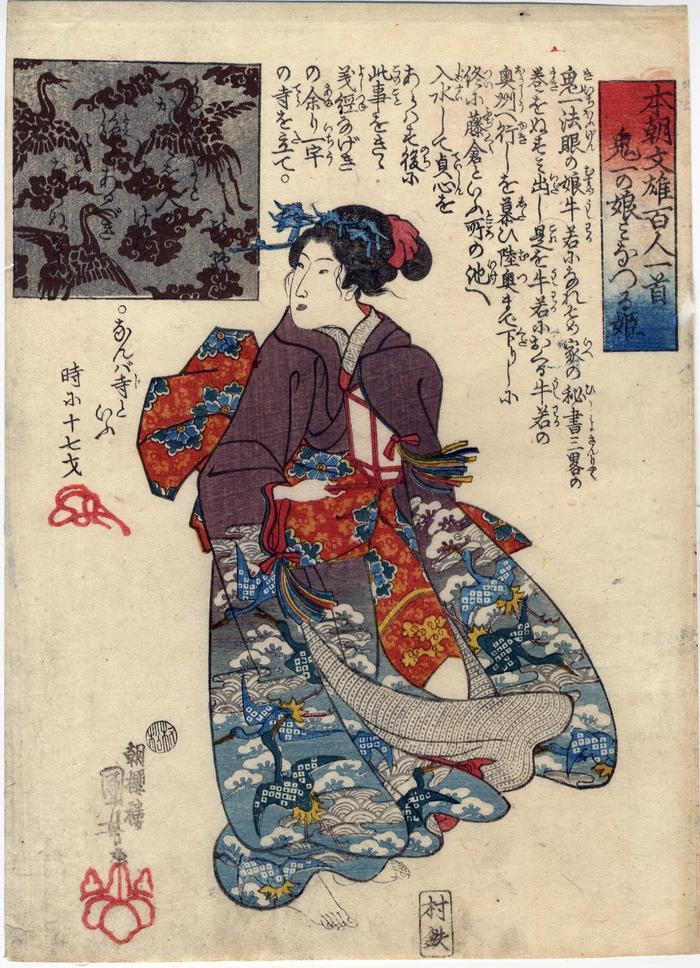Utagawa Kuniyoshi (歌川国芳) (artist 11/15/1797 – 03/05/1861)
Kiitchi's daughter, Princess Minazuru (Kiitchi no musume Minazuru-hime 鬼一の娘みなずる姫) from the series One Hundred Poets from the Literary Heroes of Our Country (Honcho bunyu hyaku nin isshu - 本朝文雄百人一首)
ca 1842 – 1844
7 in x 9.75 in (Overall dimensions) Signed: Chōōrō Kuniyoshi ga
朝櫻樓国芳画
Seal: kiri in red below signature
Publisher: Murataya Tetsu (Marks 360 - seal 25-376)
Censor's seal: Muramatsu
British Museum
Museum of Fine Arts, Boston
Hankyu Culture Foundation Minazuru-hime is shielding a lantern from the wind with her sleeve. She was a lover of Minamoto no Yoshitsune.
****
Susan Matisoff, in an article entitled Deciphering the Code of Love..., writes about the late-Muromachi-period short story Minazuru in which the lady receives a letter from her lover Yoshitsune. First the women around her look at it, but can't make heads or tails of what it is saying. "Laughing over the incompetence of the man who would write such an incomprehensible letter, they are about to rip it to shreds without delivering it to Minazuru. However, Minazuru's nurse Rensei intercedes and delivers the letter." It turns out that Yoshitsune has written it in a way which he knows only Minazuru will understand.
Minazuru does understand that each line is an allusion to famous poem and she explains this to Rensei. As Matisoff explains it, Minazuru's reading could have gone something like this:
I want to draw close to you****
My heart yearns without limit
Perhaps my longing is unknown to you
Shall I rot into old age?
Notice how the shibori-dyed flying cranes of the bottom part of Minazuru's kimono are repeated by the birds among stylized clouds in the decorative poem card in the upper left. Her robe also displays snow-covered pines plus a different type of stylized cloud motif within which is another motif of turbulent waters or waves. The blue kanzashi hairpins are another iteration of the flying cranes. Subtle, but clearly intended.
****
The text reads: 鬼一法眼の娘牛若になれそめ家の秘書三略の巻をぬすみ出し是を牛若におくる牛若の奥州へ行しを慕ひ陸奥まで下りしに終に藤倉といふ所の池へ入水して貞心をあらはす後に此事をきゝ義経なげきの余り一宇の寺を立てなんば寺といふ 時に十七才
****
This copy in the Lyon Collection differs somewhat from the ones in the British Museum. Their copies show a pinkish background at the lower part of Minazuru's robes, while the one here is blue. The delicate lines of the feet, especially her right foot are better defined than this one. And the kanji of the signature are much more clearly inked. These tell-tale elements would indicate that the print in the Lyon Collection is later than those of the other two examples cited.
****
The red seal following the characters 時に十七才 does not appear in the edition at the Hankyu Cultural Foundation.
warrior prints (musha-e - 武者絵) (genre)
Murataya Tetsu (村田屋鉄) (publisher)
